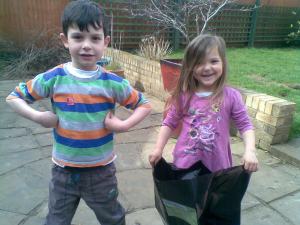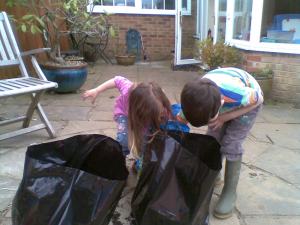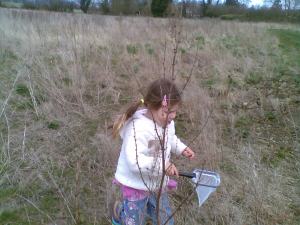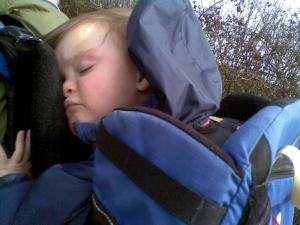Quite a few people have asked me recently how I manage to Home Educate L (aged 5) with two younger children at home. This post isn’t going to be a defence of our decision that for the moment, this is what suits L and our family, or an exploration of when or if that might change, nor is it going to provide a full explanation of the varied and interesting approaches to Home Education – but hopefully it might illustrate how not only possible but natural it is for the whole family to learn and explore together. This isn’t limited to Home Educating families of course – it happens naturally, and it’s fun.
This week the sun has been out, and we have made the most of it after being cooped up for too long (I’m all for getting children outside whatever the weather but there are only so many welly walks we can take before the novelty wears off). So we have been outside this week as much as we can, doing a bit more playground maths , planting potatoes with our pack from the Potato Council
as well as hunting for bugs and exploring the countryside. great fun, and so full of learning opportunities that it would be almost impossible to learn nothing!
We have collected and counted sticks and stones, ordered them from biggest to smallest, played “how many more shall we find to make 10?”
We have looked in puddles, rivers and streams, played “what sinks and what floats?”, predicted what might happen (both L and N thought that if they could find a big enough stick, it would not float because it would be heavy and so we have experimented with different sizes of sticks and stones)…
We have written in the soil with sticks, practising letter formation (N), sentences and joined-up writing (L) and simple mark-making (F).
We predicted which leaves / sticks / twigs would fly the furthest in the wind, what variables might change how far they travelled (how strong the wind was, how high in the air we held them, where we stood, etc), and how to make the test fair. We did the same racing sticks down a river.
We indulged in a bit (ok, a lot) of role play with natural materials aka playing with sticks, which is one of the children’s favourite pastimes at the moment (they will look around for a stick literally as soon as we leave the front door). Sticks, with a bit of imagination, have been mice, babies, rockets, tools, guns (of course, and no matter how much I discourage it), keys, a policeman’s truncheon, a knight’s sword, a magic wand…and probably more that I’ve forgotten. Whilst playing, we have explored concepts of justice, morality, punishment, sharing, giving, gender roles, the difference between looking after oneself and being selfish…all initiated by the children, and conversations we wouldn’t have had without our stick-play prompts.
And not forgetting F, who wasn’t doing much science or role play, but was nevertheless very busy exploring the properties of the things she found outdoors, trying to repeat words, clearly getting excited and pointing to things she saw, engaging with us, interacting, observing, investigating…and practising her new found skills of mark-making, standing, stepping (with support), clapping…
We also did a bit of birdwatching and identified some of the birds we saw.
The bonus “lesson” was all the positive interaction the children had, practising turn-taking and co-operation as well as building all our relationships 🙂
We also took our bug collection kit out and about on a fabulous afternoon-long Bug Hunt.
We looked at bugs, along with leaves, flowers, bark, and anything else we found, under a magnifying glass – N in particular was captivated by the detail she saw, and even had a good look at the bugs, which are not her usual favourite!
L’s favourite part was “meadow sweeping” – running through the long grass dragging a net, and examining the contents. We also considered where we might look for different kinds of bugs and worms – under stones (cool and damp) vs. the long grass (warm and dry) – introducing the idea of different habitats and adaptations.
We also took a close-up look at the sticky sap of a tree, identified different kinds of tree, and talked about what is inside a tree trunk.
And then we had an unexpected lesson about reproduction, comparing and contrasting mammals and birds, courtesy of two pheasants we met on the way home (no photo I’m afraid!),
F was tired out from all the fresh air and activity, just ready for a nap which did allow us a little bit of reading and writing based around the things we had seen.
That, my friends, is how we are currently home educating with two pre-schoolers!
























Blooming marvellous, Kate! I can’t believe how much you do with them. Here’s me thinking you never wanted to teach 😉 Do you plan your days or does it just come, directed by the kids? I’m guessing home educators can be inspected, like the rest of us? Also, just how is L reading Dahl, aged 5?!
It’s funny isn’t it, how much we all can learn from everyday life. Theres just no need to be sat in a stifling classroom for our whole childhood. How could you monitor this Lucy? I know home ed kids who can read aged 2 and some who can’t at 11 but all are receiving a valuable, full time education. If it were to be monitored then that would suggest that a curriculum would need to be followed along with develpomental milestones etc. Which would in itself be against the nature of most home ed families. Every child learns differently, in their own time at their own pace. (or at least should) What a lovely account of how organic learning can be for the whole family irrelevant of age 🙂
I agree Rachael, what I’m loving about Home Education is the way all three children can learn together, and that they can follow their own interests at their own level and nurture their love of learning (I’m not saying this never happens in school, or outside of school for schooled children, I’m just loving sharing the journey with them at the moment). I’m not completely against assessment but I don’t like the idea of them being taught to meet targets rather than for the sake of their own learning and well-being, which seems to be where the Government is going at the moment…
Ah, three of them is fun Lucy, I’m not sure I could do thirty!! We plan some and other times we take things as they come. We usually try to make the most of what they’re interested in. L is a good reader, N is well on the way, tbh I haven’t done much excepgt encourage it. I think it’s just their “thing”. I’m loving having them all at home at least for a while 🙂
I’m jolly glad that Kate’s children have a great home education. I don’t teach in a stifling classroom: it’s a very engaging and sociable environment for the children I teach. I hope that all home educated children are receiving as good an education as either my school or Kate are providing.
I know there are some inspiring and dedicated teachers out there (and I know some of them personally so I know how hard they work) – I would love to think that every child could access the education that suits them best, whether that’s at school or otherwise, or a combination of the two 🙂
Maths in the backyard is so much more fun then with pen and paper.